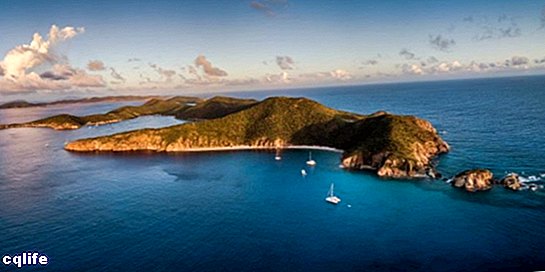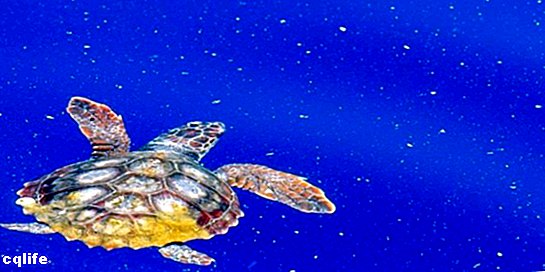- What is an island?
- Characteristics of the islands
- Formation of the islands
- Types of islands
- Plastic islands
We explain what an island is, what types exist, their characteristics and how they are formed. Also, what are the plastic islands.

What is an island?
An island is a piece of land that is naturally surrounded by Water, and which is smaller in extent than a continent, but bigger than an islet. Islands are very common in the geography world, and have form, topography and different geological origin. When several of them are together in the same region of the ocean, are known as a archipelago.
The separation of the islands from the mainland usually influences the life that develops on them, giving rise to endemic species that have evolved in isolation and independently of their continental counterparts. For many centuries, maritime exploration by the humanity It consisted of searching for secret and mysterious islands.
In fact, the islands have been very present in the imaginary of humanity since ancient times. Entire countries consist of one or more islands grouped politically, and many of them were formerly used as prison destinations or as initiatory places in which to test the warriors of the tribe, who had to survive on their own.
In this way, the islands gained an outstanding symbolic value in myths and literary stories of all times, generally as an unpublished place, in which treasures and wonders can be found, but it can also be abandoned and isolated, as in the stories of castaways. In the texts of the Ancient Greece the islands used to be populated by deities and mythological beings, such as the sorceress Circe or the daughter of the titan Atlas, Calypso.
Characteristics of the islands
In a general sense, the islands are characterized by the following:
- They consist of a portion of dry land surrounded by water on all sides. This may mean that you are in the middle of the ocean, a river, or a lake or lagoon.
- According to international standards of the Millennium Ecosystem Assessment, they must exceed 0.15 km2 in area and be separated from a continent by at least 2 km of water. However, otherwise they have a topography, weather and geography very diverse, but
- Very small islands are known as islets and are rarely populated.Instead, when it comes to many islands together, they are referred to as one archipelago.
- The largest island in the world is Greenland, with a total surface area of 2,175,000 km2, and is located in the North Atlantic Ocean.
Formation of the islands
Islands are formed as a consequence of different geological processes. Some are due to volcanic and / or sedimentary activity, which slowly accumulates materials until they harden and form a solid territorial platform.
Therefore, in theory, it is not impossible to witness the appearance of new islands after important tectonic movements or large Volcanic eruptions submarines. However, these processes usually occur in very long periods of time.
Other islands are due to historical changes in ocean water level, since the sea it has not always been at the same level as we see it today. Increasing or decreasing water can cover or expose entire portions of the continental shelf, respectively, and thus create islands or, conversely, link them to the mainland.
Types of islands

The classification of the islands responds precisely to the mechanisms that led to their appearance. So we can talk about:
Continental islands. Those that are part of the continental shelf, and therefore have the same materials, the same textures and are located in the relative proximity of the coast, although separated from the mainland by extensions of water that are not too deep (200 meters deep). depth or less). This occurs when the level of ocean water rises and submerges portions of land, "creating" islands by separating them from the rest of the continent. Examples of this type of island are:
- The Malvinas or Falklands Islands, in the South Atlantic off the Argentine coast.
- The island of Greenland, separated from North America by the Atlantic Ocean.
- The British Isles, a territory of the United Kingdom, separated from Europe by the North Sea and the English Channel.
Volcanic islands. Those that are formed due to the eruption of volcanoes submarines, which dump magma and liquid rocky materials out of the subsoil, where they cool and solidify, settling until they emerge from the water. They can be of three types: insular arches in subduction zones, mid-oceanic ridges, and intraplate hot spots. Volcanic islands are the youngest islands in geological terms, and they are not part of any continental shelf. They are examples of them:
- The Antilles, a group of islands in the Caribbean Sea.
- The islands of the archipelago of Hawaii, in the Pacific Ocean.
- The Galapagos Islands, located in the Pacific off the Ecuadorian coast.
Mixed islands. Those that are the result of the combination of volcanic and continental processes, that is, that combine both previous types. They are examples of them:
- The islands of the Aegean Sea, between Greece and Turkey.
- The islands of the Japanese territory.
Coral islands. Those that are formed in tropical and subtropical seas due to the accumulation of biological residues of corals: organisms primitive marine, whose calcareous shells are capable of reaching large proportions. When deposited on shallow underwater platforms or volcanic cones, they produce recognizable islands. Such is the case of:
- The Maldives islands, about 1,200 islands located in the Indian Ocean, 450 km off the Indian coast.
- The Los Roques archipelago, on the Venezuelan Caribbean coast.
- The Chagos Archipelago, in the Indian Ocean, 500 km south of the Maldives.
Sedimentary islands. Those that occur due to the gradual accumulation of materials as a result of the flow of larger rivers, which carry gravel, mud or sand in large quantities. Where the current loses speed, these materials settle and an island begins to form, generally around the river delta. This occurs in the cases of:
- The islands of the Orinoco delta, in eastern Venezuela.
- The islands of the Ganges river delta in India.
- The island of Marajó, at the mouth of the Amazon River, in Brazil, the largest in the world, with a size equivalent to Denmark.
River islands. Those that are formed from barriers in the central channel of a river, as its course changes historically, exposing flood-prone coastal ridges and platforms, such as sandbanks and marshy depressions. Such is the case of:
- The island of Bananal, in Brazil, considered the largest river island on the planet.
- The "aitFrom the River Thames in England, such as Eel Pie Island in Twickenham.
Plastic islands

Plastic islands, garbage islands or toxic islands are a recent and painful phenomenon, which is not due to natural geological processes, but to the lifestyle of human beings in the last century of their existence.
These are gigantic agglomerations of floating garbage that has been dumped into the sea by the human societies and that, due to the action of the elements, its particles are reduced to small sizes, close to that of a grain of rice. They are mostly made up of materials plastics and not biodegradable.
These immense islands of garbage are formed due to the circulation of oceanic water, which gradually accumulates the floating microfragments in patches of variable extension. The largest of all varies between 710,000 and 17,000,000 km2 in area, larger than the territory from many countries, and is located in the heart of the Pacific Ocean.
The garbage contained in them is not only difficult to detect from the air and by means of radars, due to their small dimensions, but it is also destroying the Marine ecosystem little by little.
Since plastic does not biodegrade, when ingested by animals it causes their death, and also obstructs the flow of plant species, preventing them from accessing the sunlight. The mere existence of this type of phenomenon would have to be a reason to stop the consumption and the manufacture of plastics throughout the world.
